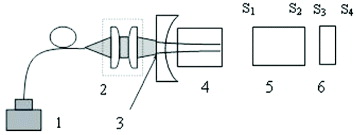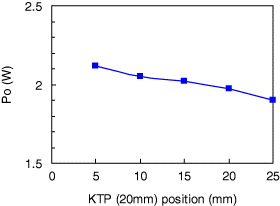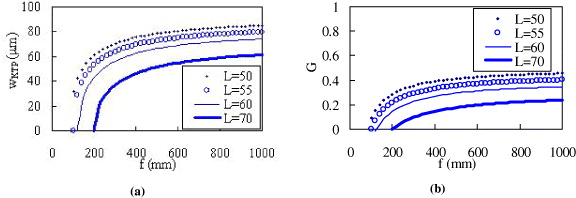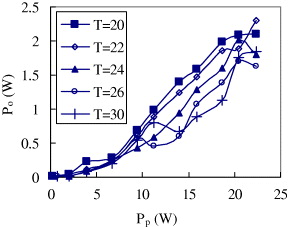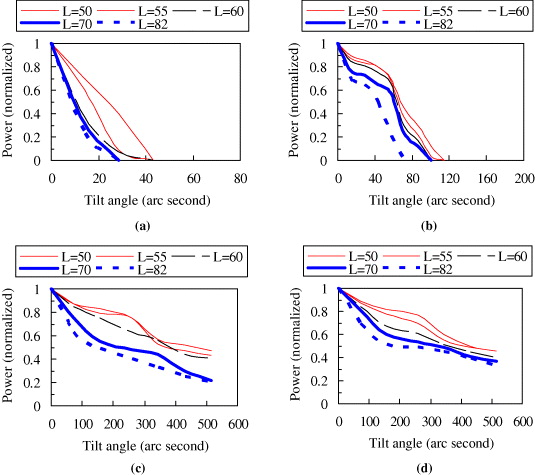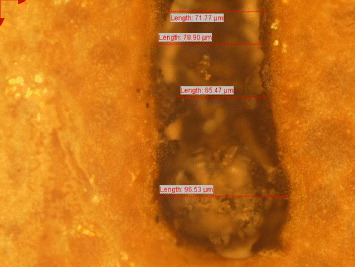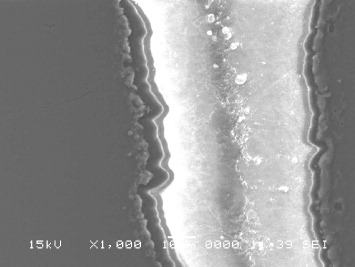Abstract
A diode-pump solid-state laser system emitting a 532 nm beam has been developed. The pump source is an 808 nm diode laser, which has gained wide acceptance in research as well as in commercial production due to its effectiveness and reasonable price. The active medium was chosen to be Nd:YVO4 (neodymium-doped yttrium orthovanadate), a material with many advantages over traditional Nd:YAG (neodymium-doped yttrium aluminum garnet) such as a low lasing threshold and linearly polarized beam. However, the thermal conductivity of Nd:YVO4 is not as good as Nd:YAG, thus the thermal lens effect inside Nd:YVO4 under high pumping intensity becomes severe and detrimental to the laser performance. Our work showed that careful adjustments of Nd:YVO4 temperature as well as of the cavity's parameters played an important role in the performance of the laser. Potassium titanyl phosphate (KTP), a nonlinear optics crystal, was used to convert the fundamental 1064 nm laser radiation from Nd:YVO4 into 532 nm. The 532 nm laser beam has been successfully proven to cut wood, plastic and aluminum.
Export citation and abstract BibTeX RIS

Content from this work may be used under the terms of the Creative Commons Attribution-NonCommercial-ShareAlike 3.0 licence. Any further distribution of this work must maintain attribution to the author(s) and the title of the work, journal citation and DOI.
1. Introduction
In the late 1980s, a reasonably priced 808 nm diode laser first appeared in the market and many scientists turned their attention to it in their search for an alternative pump source for Nd:YAG and other Nd-hosted lasers [1]. Previously, the main pump source for the Nd:YAG laser and its relatives was a flash lamp. Since the flash lamp spectrum is broad while the 808 nm diode laser spectrum is much narrower, the Nd-hosted crystal can absorb most of the power from a diode laser. The dimensions of a diode-pumped laser are also more compact than a lamp-pump system, and the life of a diode laser is longer than that for a flash lamp. Therefore, the diode-pumped solid-state laser became more attractive than the lamp-pumped solid-state laser.
Beam quality is the reason why a diode laser is not used in machining (cutting, drilling, etc) material but instead to pump a solid-state laser. A diode laser beam is of very poor quality, high divergence, high full width half maximum (FWHM) and large beam propagation factor M 2, which hinders the ability to focus the beam into a small spot. Meanwhile, the solid-state laser emits a much better beam: extremely low divergence, smaller FWHM, and very low M 2 (with the best M 2 nearly 1.2 [2], recently achieved by advanced research) close to the diffraction limit (M 2=1). Therefore, the beam from a solid-state laser can be focused into a spot of tens of micrometers, allowing cutting, drilling, scribing and marking small, fragile material such as a thin silicon wafer or sapphire wafer, which are being extensively used in the solar cell and light emitting diode (LED) industries [3].
Since the appearance of this new pump source and the advanced achievements in crystal growth technology, a series of new active mediums has been developed: Nd:YVO 4, Nd:GdVO 4 and Nd:glass, among which Nd:YVO 4 is the most interesting material. This material has an absorption cross section at 808 nm, much greater than that of Nd:YAG, and the same for the emission cross section at 1064 nm [4]. This makes the Nd:YVO 4 laser have a much lower lasing threshold than the Nd:YAG laser. However, being an anisotropic material, side pumping for Nd:YVO 4 seems inefficient and few publications about it have appeared so far. The thermal conductivity coefficient of Nd:YVO 4 is also smaller than that of Nd:YAG, thus heat management for Nd:YVO 4 is more difficult [5]. Up to now, the Nd:YAG laser has been replaced by the Nd:YVO 4 laser in low and medium power modules, but the Nd:YAG laser still dominates in high power products.
Thermal issues always play an important role in the solid-state laser. The p–n junction, which emits an 808 nm beam when injected with electrical current, also emits an amount of heat equal to approximately 50% of the input electrical power. If this heat is not dissipated, it will make the p–n junction hotter and hotter. Diode laser running at high temperature degrades quickly (increasing 10 °C halves the diode laser life). Excessively high temperature may result in instant death of the diode laser, or transform it into a cheap LED.
The temperature of the active medium also strongly affects the laser output. When Nd:YVO 4 absorbs an 808 nm beam, part of the energy is wasted as heat inside the crystal and creates a temperature gradient. The crystal then becomes a thermal lens. The crystal may also fracture under a steep temperature gradient [6].
In our laser, a 532 nm beam was created by passing the 1064 nm beam through potassium titanyl phosphate (KTP) crystal. This conversion is known to be second harmonic generation (SHG), a process in which a wave propagating through a nonlinear optical crystal is converted into another wave with doubled frequency (meaning halved wavelength). In our situation, the 1064 nm wave is called the fundamental wave, and the 532 nm wave is called the second harmonic wave. In nonlinear optics it is known that the efficiency of converting the fundamental beam into the second harmonic beam is [7]

where Iλ /2 ,Iλ are the intensities (Watt m −2) of the second harmonic beam (λ /2=532 nm) and fundamental beam (λ=1064 nm), respectively, l is the length of the nonlinear crystal, ε 0 and c are the dielectric constant and light speed in a vacuum, nλ and nλ /2 are the refractive indices (in the crystal) of the 1064 and 532 nm waves, d is the nonlinear optical coefficient of the crystal and .
In formula (
The nonlinear crystal may be put inside or outside the laser cavity, leading to two corresponding SHG configurations: intracavity second harmonic generation (ICSHG) or extracavity second harmonic generation (ECSHG). Because the laser beam oscillating inside the cavity is always much more intense than the beam which exits through the output mirror, the ICSHG configuration yields a more powerful second harmonic beam than the ECSHG configuration [6]. Therefore, in this work we utilized the ICSHG configuration.
Inside our laser cavity a standing 1064 nm wave is formed. The diameter of this beam inside the laser cavity is decided by the geometry of the cavity. In particular, the beam diameter on the plane mirror of the concave-plane cavity is [8]

where R is the radius of curvature of the concave mirror, L is the distance between two mirrors (also called the cavity length), w is the diameter of the beam at the plane mirror and λ=1064 nm.
The beam diameter is largest at the concave mirror and decreases to a minimum at the plane mirror [6], as presented in figure 1, which helps in choosing the right position for the nonlinear crystal inside the cavity.
Figure 1 Diameter of the laser beam inside the cavity.
In our previous papers [9, 10], stability and the thermal lens effect were investigated. In this work, a laser pumped by an 808 nm diode laser was constructed and tested on several materials. The active medium was Nd:YVO 4 crystal and ICSHG was performed with two KTP crystals. The resonator was of concave-plane configuration. The temperature at the Nd:YVO 4 crystal was stabilized at different temperatures to investigate their effects and find the optimal value. Cavity parameters such as cavity length and KTP position were also investigated. The sensitivity of the laser with respect to misalignments of each optical components was measured. The laser emits 2.2 W of 532 nm beam, and is capable of cutting Al film, plastic sheet and wood plate. Silicon and sapphire wafer, materials with higher thermal conductivity and higher melting temperature, seem intact following the laser irradiation.
2. Experimental
In the pumping module, an 808 nm diode laser (40 W fiber-coupled diode laser, from Spectra) was in good thermal contact with a steel heat sink. A temperature control unit (figure 2(a)) with microprocessor PIC16F877A was developed at LNT to monitor the temperature at the diode laser and control the water flow as well as a thermo electric cooler. The thermo electric cooler (figure 2(b)), which operates under the Peltier effect, transfers the heat to an aluminum water block.
Figure 2 Temperature controller board (a) and a thermo electric cooler (b).
The diode laser beam (figure 3) from the fiber was coupled to the Nd:YVO 4 through a collimating lens and a focus lens with focal lengths of 35 and 22 mm, respectively. The active medium was Nd:YVO 4 doped 0.27% (3×3×12 mm). One side of the crystal is coated by thin films to have anti reflection (AR) at 1064 nm (R=0.1%) and 808 nm (R=5%), the other side is coated AR at 1064 nm. The crystal was put into a copper water block. The water temperature is kept at 15 °C, and the water flow is controlled by the temperature control unit. Doubling frequency was achieved by a KTP crystal 3×3×20 mm (coated AR at 1064 nm (R=0.1%) and 532 nm (R=0.5%) on both sides) and a KTP crystal 2×2×5 mm (coated high reflection (HR) at 1064 nm (R=99.8%), AR at 532 nm (R=0.5%) at one side to assume the role of the output mirror of the cavity.
Figure 3 Setup of the 532 nm laser system. 1: Fiber diode laser; 2: coupling lenses; 3: input mirror M 1; 4: Nd:YVO 4; 5: KTP 20 mm; 6: KTP 5 mm.
The cavity was formed by a concave mirror M 1 (radius of curvature 100 mm) and face S 4 of the 5 mm long KTP, thus it is a concave-plane cavity. The plane face of M 1 is AR coated at 808 nm, the concave face of M 1 is HR coated at 1064 nm (R=99.8%), 532 nm (R=99%), AR at 808 nm. Cavity length varies with values below 85 mm. The active medium, KTP crystals and mirrors are from Casix Inc, China.
An infrared (IR) filter (CNI, China), 5×5×1 mm, was used at the output end to cut off all residual 808 nm or 1064 nm beam before the beam entered the power meter for measurement. The transmittances of this IR filter at 808 and 1064 nm are below 10−6.
The power of the 532 nm beam was measured using an integrated sphere S142C and power meter PM100D from Thorlabs, USA, capable of measuring laser power with wavelengths from 350 to 1100 nm. The integrated sphere has an inner wall collecting the total beam power, and thus can measure beams with large diameter or large divergence. Its input aperture is 12 mm. The spectrum of the 532 nm beam is measured with an ELT-1000 spectrometer (Ecopia Corp, Korea) at LNT.
The 532 nm laser beam was tested on Al thin film coated on glass, plastic, wood, silicon wafer and sapphire wafer. The imaging devices are a GX51 metallurgical microscope (Olympus, Japan) and JSM-6480LV scanning electron microscope (Jeol Inc, Japan) at LNT.
3. Results and discussion
3.1. The influence of KTP position
Figure 4 shows the power of the 532 nm beam when the pump power of the 808 nm laser diode is 16.7 W. The 20 mm long KTP position is the distance between surfaces S 2 and S 4. It can be seen that the further the 20 mm long KTP gets from the S 4 surface, the lower the output power becomes.
Figure 4 Power of the 532 nm beam (P0) as a function of KTP (20 mm long) position with respect to the S 4 surface.
The 20 m long KTP and 5 mm long KTP both contribute to converting the 1064 nm beam into the 532 nm beam. From figure 1 and equation (
3.2. The influence of cavity length
The effect of cavity length can be seen clearly from figure 5. A long cavity, which has a significant distance between two mirrors, can attain high output power at low input pump power. For example, the 70 mm long cavity can easily emit 0.55 W of 532 nm laser beam at 6.6 W pump power, while the 50 mm long cavity can emit only 0.24 W.
Figure 5 Power of the 532 nm beam (P o ) as a function of pump power (P p ) with various cavity lengths.
However, the performance of a long cavity degrades at high pump power. A 70 mm long cavity can only yield at most 1.23 W of 532 nm laser beam at 14 W pump power. After that, more pump power would only decrease the power of the 532 nm beam. The short cavity exhibits its superiority at this high pump power: the 50 mm long cavity shows no end in increasing output—it can emit 2.2 W of 532 nm beam at 22.3 W pump power.
When the cavity length is 82 mm, the output is extremely low, and when the cavity length is longer than 85 mm there is no output, even when pump power is as high as 40 W. Therefore, the laser cavity is only stable for cavity lengths shorter than 85 mm.
Because of the stability condition mentioned in [6, 9], L can be neither negative nor greater than R (when L>R the cavity becomes unstable and no laser beam can be produced at all) and thus can only be adjusted from 0 to R. From equation (
The Nd:YVO 4 absorbs 808 nm pump beam, converting part into laser beam energy and the rest transforms into heat energy. There will be a temperature gradient inside the Nd:YVO 4 crystal: the core of the Nd:YVO 4 will be the hottest region, while the periphery, which is cooled by a copper heat sink, is the coolest region. The temperature gradient creates a refractive index gradient making the Nd:YVO 4 act like a lens-like medium with focal length f [6]:

where K is the thermal conductivity coefficient, w p is the average pump spot size, P h is the pump power wasted as heat inside the crystal, d n/d T is the change of refractive index versus temperature, α is the absorbance coefficient at 808 nm and l is the crystal length.
P h increases as pump power increases, thus at high pump power the Nd:YVO 4 equivalent focal length becomes shorter. The laser cavity is no longer simply a concave-plane cavity, but becomes a concave-plane cavity with internal lens. The stability and beam diameter inside this cavity are no longer the same as those inside a simple concave-plane cavity. The laser cavity parameters are given below [6]:

where L1 and L2 are the distance from the thermal lens to mirror 1 and mirror 2 and L is the total cavity length.
The beam diameters at surface S4 also change with changes of the cavity parameters [7]:

The stability of a cavity is quantified through the product of the two cavity parameters:

The cavity is stable provided G satisfies the following condition:

A laser cavity with G around 0.5 has the best stability; G which is either negative nor greater than unity represents an unstable cavity (a cavity with such high diffraction loss that it can't resonate at all, no matter how high the pump power is); G near zero or near unity represents a cavity with high diffraction loss and emits a weak laser beam, despite being strongly pumped.
As pump power increases, P
h
increases, thus f decreases (equation (
Figure 6 Variation of 1064 nm beam waist (in μm) at surface S 4 (a) and stability G (b) at different thermal lenses.
Figure 6(a) shows the 1064 nm beam waist at the S 4 surface of the 5 mm long KTP with respect to thermal lens. We can see that longer cavities have a smaller beam diameter at KTP crystals. That is very likely the reason why the 70 mm long cavity easily reaches 0.55 W of 532 nm beam at 6.6 W pumping. As pump power increases, the beam waist at S4 decreases quickly down to zero and attains an extremely small value in a long cavity, but why in reality do we see that the output power of a long cavity is very poor under high power pumping?
The reason may be the stability. A short cavity, despite having a large 1064 nm beam diameter at the KTP position, has high stability. Figure 6(b) shows that the G value of the 50 mm long cavity at low pump power is as high as 0.5, and only reaches zero at very high pump power (equivalent to very short f, nearly 100 mm). Meanwhile, G of the 70 mm long cavity is only 0.2 at low pumping and quickly reaches zero at f=200 mm. This means that at low pump power, a long cavity has the advantage of a small beam diameter at KTP (thus large SHG conversion efficiency), but at high pump power, it becomes inferior to the short cavity due to lower stability.
The threshold pump power is the minimum power that the diode laser must pump into Nd:YVO 4 so that the cavity starts emitting the 532 nm beam. In our experiment, the threshold pump power is recorded when the collected power of 532 nm beam is more than 0.01 W. Through the data in table 1, we can see that the longer cavity has a higher pump threshold than the short cavity.
Table 1. Threshold pump power versus cavity length.
| Threshold pumping (W) | 0.19 | 0.22 | 1.11 | 2.03 |
3.3. The effect of temperature at Nd:YVO 4
The effect of Nd:YVO 4 temperature is shown in figure 7 (the cavity length is 50 mm and the 20 mm long KTP distance from S 4 is 5 mm). A temperature of 22 °C seems to be the optimal temperature for the laser system in this power range. At 30 °C, the laser output is only 1.85 W at pump power 22.3 W, while at 22 °C the laser output is 2.3 W. At 20 °C, the performance is worse than at 22 °C. More data and maybe a mathematic model are necessary to explain why 22 °C is better than 20 °C.
Figure 7 System output power versus pump power at different temperatures.
3.4. Misalignment sensitivity
An important characteristic of a laser system is its stability against misalignment of optical components, which are the angular or translational displacement of optical components from the aligned position. Optical components with plane surfaces, such as the plane–plane mirror, KTP crystal or Nd:YVO 4 rod, are perfectly aligned if the normal of the plane surfaces is parallel to the optical axis of the system. An optical component with a curved surface, such as a lens or concave-plane mirror, is perfectly aligned if its center of curvature lies on the system optical axis, and its optical axis must also coincide with the system of optical axis [11].
A plane–plane component misalignment is the tilt from the optical axis, while misalignment of a component with a curved face may be the shift of its center or a tilt of its optical axis from the optical axis of the system. Misalignment causes additional loss because the laser beam no longer overlaps with the pump beam. Misalignment sensitivity plays an important role in commercial lasers and a critical role in military lasers. Commercial lasers must be subject to vibration during transport or installing. Military lasers are subject to much more severe> impacts during harsh conditions. Such vibration causes more or less tilt or shift of components in the laser cavity. A good laser must be able to maintain its output power within an allowable range under such vibration.
In this paper we use the 50% criterion (the tilt angle or the shift of optical components at which the laser output drops 50%) to compare misalignment sensitivity between cavities. The optical components in our laser system (figure 8) were placed on stable holders with knobs to precisely tune the tilt and the shift. The tilt resolution is 50 mrad per revolution. We present the result of variation of output power versus tilt only.
Figure 8 A misaligned laser system.
Figure 9 shows the output power of each laser cavity configuration with respect to the tilt of the mirror M 1 (a), the 5 mm long KTP (b), the 20 mm long KTP (c) and the Nd:YVO 4 crystal (d). From the graph it can be seen that a short cavity is less prone to tilt than a long cavity. In an 82 mm long cavity, the 50% tilt angles are 10, 43, 157 and 257 arc seconds for the M1 mirror, 5 mm long KTP, 20 mm long KTP and Nd:YVO 4, respectively. One can see that the effect of the Nd:YVO 4 tilt is least compared to other optical components' tilts (257 arc seconds make the output drop 50%). The system is most prone to tilt of mirror M 1 (10 arc seconds make the output drop 50%).
Figure 9 Output drop versus tilt of mirror M 1 (a), 5 mm long KTP (b), 20 mm long KTP (c) and Nd:YVO 4 (d).
3.5. Spectrum of the laser beam
Figure 10 is the spectrum of the laser beam, with spectral peak at 532.1 nm and FWHM of 5.6 nm.
Figure 10 Spectrum of the 532 nm beam in full 400–100 nm range (a) and zoomed 500–560 nm range (b).
3.6. Micromachining result
The 2 W, 532 nm beam has been tested on several materials, including Al thin film (500 nm thick) sputtered on glass substrate, plastic sheet, wood sheet, p-type monocrystalline silicon wafer (200 μm thick) and sapphire wafer (650 μm thick). The focusing lens is an aspheric lens with 18 mm aperture and 12 mm focal length. On the silicon wafer and sapphire wafer, the beam left no sign of damage as seen under the naked eye or imaging device. Meanwhile, the beam left grooves on the Al film, plastic and wood sheets. Figures 11 and 12 are images of the etched grooves on wood and plastic sheet, taken by the metallurgical microscope, and figure 13 is a SEM image of etched grooves on Al thin film.
Figure 11 Groove on wood etched with the 532 nm beam.
Figure 12 Groove on plastic sheet etched with the 532 nm beam.
Figure 13 Groove on Al thin film etched with the 532 nm beam.
The results show that a 2 W, 532 nm beam is capable of etching wood and plastic, which conduct heat badly and are rather easy to burn. The laser can also etch Al, a metal with quite low melting temperature (620 °C). Silicon wafer and sapphire have high thermal conductivities and high melting temperature, so 2 W is not enough to leave damage on the surfaces. For these and similar materials, a pulse beam or a very high power continuous wave beam may give a better effect.
4. Conclusion
We have successfully developed a 532 nm diode-pumped solid-state ICSHG laser system capable of emitting 2 W power. At high pump power, the detrimental thermal lens inside the Nd:YVO 4 lowers the output power. The short laser cavity length has a critical role in minimizing the thermal lens effect: despite yielding low output at low pump, it has higher stability to compensate for the detrimental effect of the thermal lens. A 55 mm long cavity is best to obtain a 2 W laser at lowest pump power. Nd:YVO 4 temperature tuning also helps optimize output: 22 °C is the best temperature in the case of our system.
Misalignment of the optics components has been investigated and the results show that the laser output is most sensitive to the input mirror's tilt and is least sensitive to the Nd:YVO 4 tilt.
A 2 W, 532 nm laser beam was also tested successfully to etch Al thin film, wood and plastic. For silicon and sapphire wafer, the laser beam inflicts no damage.
Acknowledgment
This work is supported by the Vietnam National University in Ho Chi Minh City, through contract number B2008-76-04TD.



